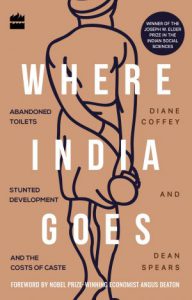
Picture Courtesy: r.i.c.e.
By Diane Coffey and Dean Spears
(Excerpted from a Pathbreaking Book: Where India Goes – Abandoned Toilets, Stunted Development and the Costs of Caste: Diane Coffey and Dean Spears, Published by HarperCollins, 2017)
India was not always an outlier in rural sanitation. There was a time when open defecation was the only thing that humans did with their faeces. Not so many decades ago, rural open defecation rates would have been high in essentially every country. India stands alone today not because it changed, but because the rest of the world did.
The global decline in open defecation is only one of many rapid improvements in human well-being that have defined the past century. Robert Fogel, a Nobel Prize–winning economist, described the world in 2004 as having made three centuries of progress towards an ‘escape from hunger and premature death’ which he dates from 1700 to 2100. Economist Angus Deaton, also a Nobel laureate, called these sweeping changes humanity’s ‘Great Escape’. Lives are longer, fewer people are hungry, children are taller, and more people can read and choose how to live their lives, all around the world. These are big advances, and they reflect big underlying scientific, social and economic changes.
These improvements are unmistakable in demographic data. They often reinforce one another. Better early-life health permits children to learn more and, as adults, to earn more, so that they can then provide a better environment for the next generation. Greater social equality means that more girls attend school, have more power over their own lives and become mothers at later ages, and know more about how to keep their children safe from disease.
In a world that is improving so fast, it can be difficult to be sure what, if anything, could further speed these existing trends. Just because the Great Escape is measurable does not mean that it is under anyone’s control. This is a central question of our book: Can development efforts add something extra to a world that is already part-way through a rapid Great Escape? If so, how?
The answer may be in the second part of Deaton’s thesis: inequality. When Deaton describes demographic trends as an escape, he wants us to remember that many escapes leave somebody struggling behind. The human development of the twentieth and twenty-first centuries is no exception: Escape causes inequality. When infant mortality falls more quickly in China or even in Bangladesh or Nepal than it does in India, it creates inequality among the world’s children.
International development is known for asking big questions. In the 1990s, the Washington Consensus asked how to get prices right for development. In the first decade of this millennium, the UN collaborated with celebrities to ask how to make poverty history. The evidence-based policy revolution of the past decade summarizes itself by asking simply: what works? Often, the question has been only that simple, presuming a solution that works for everyone. The reality of a fast but uneven and unequal Great Escape suggests two different questions. First, how can change be accelerated in the places and on the issues that are improving only slowly? Second, how can ongoing rapid improvements be pushed to go a little more quickly?
Comparing open defecation in India with sanitation elsewhere makes plainly visible the need to keep these questions separate. To answer them, one must contrast a problem that is found in a slowly improving place against a record of faster improvement almost worldwide. The result can usefully clarify what is important. For example, sanitation was an undeniably central part of how mortality declined and health improved in the countries that are now rich. Differences in sanitation explain many differences in outcomes across developing countries today. So, it is no surprise that what today ranks as unusually terrible sanitation contributes to pushing India off the global trend of improving health and well-being.
But comparing India with the rest of the developing world also reveals that whatever was responsible for improving sanitation elsewhere either has not been available or has not worked the same way in rural India. Such is the dilemma at the heart of this book. Much of the world has experience with drastically reducing open defecation. It is exactly from that international and historical experience that experts have learnt just how important sanitation is and just how harmful faecal germs can be. But the very fact that rural India lags so far behind in sanitation suggests that the experience of the rest of the world may tell us little about how to accelerate the switch to safe sanitation in rural India. If India’s leaders, sanitation experts and development professionals want to help rural India become like everywhere else, they must devise a new strategy based on both understanding the consequences of poor sanitation that India shares with other, often past, populations and understanding why rural India remains unique.
####
In the view from the government offices and the hotel conference rooms of development, poverty bears the responsibility for depriving poor people of access to what they need. Villages are communities where poor people come together to help one another. Poor people lack options to choose among, but experts know how to empower the poor to make themselves and their neighbours better off. Democratic pressure demands that governments make these changes. Development experts are useful because they can apply lessons to one country (or within India, one state or district) that they learnt by being responsible for improvements elsewhere.
All of this may be true in some cases, but open defecation in rural India turns development platitudes upside down. Open defecation initially appears to be an easy problem to solve. Even the most free-market-oriented economist recognizes that sanitation requires subsidy and public action to prevent one family from dumping its germs on another. So, the obvious solution is for the state to distribute free latrines. We agree that free latrines, targeted to people likely to use them, could be a small part of an effective response – in the unlikely case that such a programme could be managed without consuming all of policy attention available for sanitation. But in rural India, poverty itself is not the problem, and subsidized latrines are not nearly enough to solve it. Far too many free latrines are never wanted or never used. Even when they receive a latrine that would be recognized as perfectly functional in other developing countries, people in rural India defecate in the open.
The fact that many people in rural India who receive a government latrine nevertheless choose to defecate in the open surprises many city dwellers. But it is perfectly reasonable to many people in rural north India who can explain to a curious visitor what is wrong with government latrines and why open defecation is a superior option.
There are illiberal ideas in every culture. Unique to Ramila’s culture are the particular illiberal notions of untouchability and ritual purity that people in her village would invoke while rejecting a functional government latrine. These are not ideas that will be convenient or comfortable to address for a government which is dominated by higher-caste urbanites – and which perpetuates manual scavenging even in its own investment decisions and hiring practices. Nor are international development professionals likely to bring these issues to the fore: Culturally sensitive development professionals cannot admit that cultures differ. One reason is that it is unacceptable for outsiders to blame the victim by acknowledging that poor people, like rich people, often harm one another. Another reason is that the fact that cultural differences or other place specific causes could have important effects challenges the role of international expertise.
Left with no other admissible explanation, sanitation experts repeat the claim that people in rural India lack access to latrines due to poverty. A few do. Yet, the standard invocation of access to latrines denies the plain fact that quality sanitary latrines are purchased or made inexpensively in most developing countries. The mantra of access denies the agency that villagers so clearly have.
International development cannot recognize what is unique about Indian open defecation; meanwhile, domestic democratic pressure has no reason to focus on it. It is rural citizens’ own behaviour that harms their neighbours, after all. Villagers are not aware that open defecation kills children and so they have no reason to electorally punish their local councils for failing to make their neighbours use latrines. In villagers’ minds, open defecation is a far superior choice to storing faeces in a government-provided latrine pit that would need to be emptied by hand, an activity which invokes a generations-old struggle between people who are still too often thought of as ‘Untouchables’ and those who still too often exploit, exclude and humiliate them. It is no wonder that Ramila was far happier to receive a storage room and washing slab than she would have been to receive a functional government latrine.
A problem that cannot be solved through construction funds, democratic pressure, international expertise, cooperative community engagement, decades of economic growth or subsidy is a problem that will be difficult to fix with the familiar tool kit of development policy.
####

(Excerpted with permission from Dean Spears – coauthor of Where India Goes, HarperCollins)
Brief Profiles of Authors:
Diane Coffey and Dean Spears are visiting researchers at the Economics and Planning Unit of the Indian Statistical Institute in Delhi, assistant professors at the University of Texas at Austin and executive directors of r.i.c.e., a research institute for compassionate economics, online at www.riceinstitute.org.


















